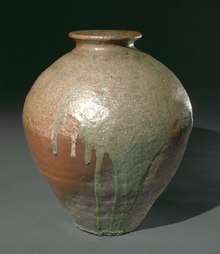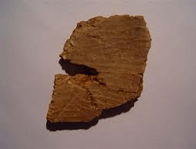Pottery
Pottery is the process and the products of forming vessels and other objects with clay and other ceramic materials, which are fired at high temperatures to give them a hard, durable form. Major types include earthenware, stoneware and porcelain. The place where such wares are made by a potter is also called a pottery (plural "potteries"). The definition of pottery used by the American Society for Testing and Materials (ASTM), is "all fired ceramic wares that contain clay when formed, except technical, structural, and refractory products."[1] In archaeology, especially of ancient and prehistoric periods, "pottery" often means vessels only, and figures etc. of the same material are called "terracottas". Clay as a part of the materials used is required by some definitions of pottery, but this is dubious.
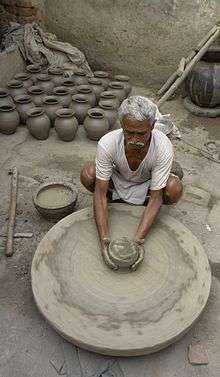
Pottery is one of the oldest human inventions, originating before the Neolithic period, with ceramic objects like the Gravettian culture Venus of Dolní Věstonice figurine discovered in the Czech Republic dating back to 29,000–25,000 BC,[2] and pottery vessels that were discovered in Jiangxi, China, which date back to 18,000 BC. Early Neolithic and pre-Neolithic pottery artifacts have been found, in Jōmon Japan (10,500 BC),[3] the Russian Far East (14,000 BC),[4] Sub-Saharan Africa (9,400 BC),[5] South America (9,000s-7,000s BC),[6] and the Middle East (7,000s-6,000s BC).
Pottery is made by forming a ceramic (often clay) body into objects of a desired shape and heating them to high temperatures (600-1600 °C) in a bonfire, pit or kiln and induces reactions that lead to permanent changes including increasing the strength and rigidity of the object. Much pottery is purely utilitarian, but much can also be regarded as ceramic art. A clay body can be decorated before or after firing.
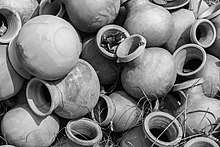
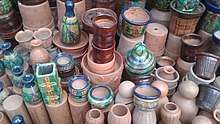
Clay-based pottery can be divided into three main groups: earthenware, stoneware and porcelain. These require increasingly more specific clay material, and increasingly higher firing temperatures. All three are made in glazed and unglazed varieties, for different purposes. All may also be decorated by various techniques. In many examples the group a piece belongs to is immediately visually apparent, but this is not always the case. The fritware of the Islamic world does not use clay, so technically falls outside these groups. Historic pottery of all these types is often grouped as either "fine" wares, relatively expensive and well-made, and following the aesthetic taste of the culture concerned, or alternatively "coarse", "popular", "folk" or "village" wares, mostly undecorated, or simply so, and often less well-made.
Main types
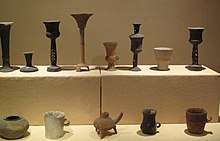
Earthenware
All the earliest forms of pottery were made from clays that were fired at low temperatures, initially in pit-fires or in open bonfires. They were hand formed and undecorated. Earthenware can be fired as low as 600 °C, and is normally fired below 1200 °C.[7] Because unglazed biscuit earthenware is porous, it has limited utility for the storage of liquids or as tableware. However, earthenware has had a continuous history from the Neolithic period to today. It can be made from a wide variety of clays, some of which fire to a buff, brown or black colour, with iron in the constituent minerals resulting in a reddish-brown. Reddish coloured varieties are called terracotta, especially when unglazed or used for sculpture. The development of ceramic glaze made impermeable pottery possible, improving the popularity and practicality of pottery vessels. The addition of decoration has evolved throughout its history.
Stoneware
Stoneware is pottery that has been fired in a kiln at a relatively high temperature, from about 1,100 °C to 1,200 °C, and is stronger and non-porous to liquids.[8] The Chinese, who developed stoneware very early on, classify this together with porcelain as high-fired wares. In contrast, stoneware could only be produced in Europe from the late Middle Ages, as European kilns were less efficient, and the right type of clay less common. It remained a speciality of Germany until the Renaissance.[9]
Stoneware is very tough and practical, and much of it has always been utilitarian, for the kitchen or storage rather than the table. But "fine" stoneware has been important in China, Japan and the West, and continues to be made. Many utilitarian types have also come to be appreciated as art.
Porcelain
.tif.jpg)
Porcelain is made by heating materials, generally including kaolin, in a kiln to temperatures between 1,200 and 1,400 °C (2,200 and 2,600 °F). This is higher than used for the other types, and achieving these temperatures was a long struggle, as well as realizing what materials were needed. The toughness, strength and translucence of porcelain, relative to other types of pottery, arises mainly from vitrification and the formation of the mineral mullite within the body at these high temperatures.
Although porcelain was first made in China, the Chinese traditionally do not recognise it as a distinct category, grouping it with stoneware as "high-fired" ware, opposed to "low-fired" earthenware. This confuses the issue of when it was first made. A degree of translucency and whiteness was achieved by the Tang dynasty (AD 618–906), and considerable quantities were being exported. The modern level of whiteness was not reached until much later, in the 14th century. Porcelain was also made in Korea and in Japan from the end of the 16th century, after suitable kaolin was located in those countries. It was not made effectively outside East Asia until the 18th century.[10]
Production stages
Before being shaped, clay must be prepared. Kneading helps to ensure an even moisture content throughout the body. Air trapped within the clay body needs to be removed. This is called de-airing and can be accomplished either by a machine called a vacuum pug or manually by wedging. Wedging can also help produce an even moisture content. Once a clay body has been kneaded and de-aired or wedged, it is shaped by a variety of techniques. After it has been shaped, it is dried and then fired.
- Greenware refers to unfired objects. At sufficient moisture content, bodies at this stage are in their most plastic form (as they are soft and malleable, and hence can be easily deformed by handling).
- Leather-hard refers to a clay body that has been dried partially. At this stage the clay object has approximately 15% moisture content. Clay bodies at this stage are very firm and only slightly pliable. Trimming and handle attachment often occurs at the leather-hard state.
- Bone-dry refers to clay bodies when they reach a moisture content at or near 0%. At that moisture content, the item is ready to be fired.
- Biscuit (or bisque)[11][12] refers to the clay after the object is shaped to the desired form and fired in the kiln for the first time, known as "bisque fired" or "biscuit fired". This firing changes the clay body in several ways. Mineral components of the clay body will undergo chemical and physical changes that will change the material.
- Glaze fired is the final stage of some pottery making, or glost fired.[13] A glaze may be applied to the bisque form and the object can be decorated in several ways. After this the object is "glazed fired", which causes the glaze material to melt, then adhere to the object. Depending on the temperature schedule the glaze firing may also further mature the body as chemical and physical changes continue.
Clay bodies and mineral contents

Body is a term for the main pottery form of a piece, underneath any glaze or decoration. The main ingredient of the body is clay. There are several materials that are referred to as clay. The properties which make them different include: Plasticity, the malleability of the body; the extent to which they will absorb water after firing; and shrinkage, the extent of reduction in size of a body as water is removed. Different clay bodies also differ in the way in which they respond when fired in the kiln. A clay body can be decorated before or after firing. Prior to some shaping processes, clay must be prepared. Each of these different clays is composed of different types and amounts of minerals that determine the characteristics of resulting pottery. There can be regional variations in the properties of raw materials used for the production of pottery, and these can lead to wares that are unique in character to a locality. It is common for clays and other materials to be mixed to produce clay bodies suited to specific purposes. A common component of clay bodies is the mineral kaolinite. Other minerals in the clay, such as feldspar, act as fluxes which lower the vitrification temperature of bodies. Following is a list of different types of clay used for pottery.[14]
- Kaolin, is sometimes referred to as china clay because it was first used in China. Used for porcelain.
- Ball clay An extremely plastic, fine grained sedimentary clay, which may contain some organic matter. Small amounts can be added to porcelain bodies to increase plasticity.
- Fire clay A clay having a slightly lower percentage of fluxes than kaolin, but usually quite plastic. It is highly heat resistant form of clay which can be combined with other clays to increase the firing temperature and may be used as an ingredient to make stoneware type bodies.
- Stoneware clay Suitable for creating stoneware. Has many of the characteristics between fire clay and ball clay, having finer grain, like ball clay but is more heat resistant like fire clays.
- Common red clay and shale clay have vegetable and ferric oxide impurities which make them useful for bricks, but are generally unsatisfactory for pottery except under special conditions of a particular deposit.[15]
- Bentonite An extremely plastic clay which can be added in small quantities to short clay to increase the plasticity.
Methods of shaping
Pottery can be shaped by a range of methods that include:
- Hand-building. This is the earliest forming method. Wares can be constructed by hand from coils of clay, combining flat slabs of clay, or pinching solid balls of clay or some combination of these. Parts of hand-built vessels are often joined together with the aid of slip, an aqueous suspension of clay body and water. A clay body can be decorated before or after firing. Prior to some shaping processes, clay must be prepared, such as tablewares, although some studio potters find hand-building more conducive to create one-of-a-kind works of art.
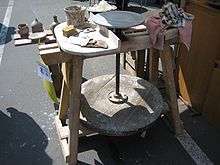
- The potter's wheel. In a process called "throwing" (coming from the Old English word thrownاا which means to twist or turn,[16]) a ball of clay is placed in the center of a turntable, called the wheel-head, which the potter rotates with a stick, with foot power or with a variable-speed electric motor.
- During the process of throwing, the wheel rotates while the solid ball of soft clay is pressed, squeezed and pulled gently upwards and outwards into a hollow shape. The first step of pressing the rough ball of clay downward and inward into perfect rotational symmetry is called centring the clay—a most important skill to master before the next steps: opening (making a centred hollow into the solid ball of clay), flooring (making the flat or rounded bottom inside the pot), throwing or pulling (drawing up and shaping the walls to an even thickness), and trimming or turning (removing excess clay to refine the shape or to create a foot).
- Considerable skill and experience are required to throw pots of an acceptable standard and, while the ware may have high artistic merit, the reproducibility of the method is poor.[13] Because of its inherent limitations, throwing can only be used to create wares with radial symmetry on a vertical axis. These can then be altered by impressing, bulging, carving, fluting, and incising. In addition to the potter's hands these techniques can use tools, including paddles, anvils & ribs, and those specifically for cutting or piercing such as knives, fluting tools, needle tools and wires. Thrown pieces can be further modified by the attachment of handles, lids, feet and spouts.
- Granulate pressing: As the name suggests, this is the operation of shaping pottery by pressing clay in a semi-dry and granulated condition in a mould. The clay is pressed into the mould by a porous die through which water is pumped at high pressure. The granulated clay is prepared by spray-drying to produce a fine and free-flowing material having a moisture content of between about 5 and 6 per cent. Granulate pressing, also known as dust pressing, is widely used in the manufacture of ceramic tiles and, increasingly, of plates.
- Injection moulding: This is a shape-forming process adapted for the tableware industry from the method long established for the forming of thermoplastic and some metal components.[17] It has been called Porcelain Injection Moulding, or PIM.[18] Suited to the mass production of complex-shaped articles, one significant advantage of the technique is that it allows the production of a cup, including the handle, in a single process, and thereby eliminates the handle-fixing operation and produces a stronger bond between cup and handle.[19] The feed to the mould die is a mix of approximately 50 to 60 per cent unfired body in powder form, together with 40 to 50 per cent organic additives composed of binders, lubricants and plasticisers.[18] The technique is not as widely used as other shaping methods.[20]
- Jiggering and jolleying: These operations are carried out on the potter's wheel and allow the time taken to bring wares to a standardized form to be reduced. Jiggering is the operation of bringing a shaped tool into contact with the plastic clay of a piece under construction, the piece itself being set on a rotating plaster mould on the wheel. The jigger tool shapes one face while the mould shapes the other. Jiggering is used only in the production of flat wares, such as plates, but a similar operation, jolleying, is used in the production of hollow-wares such as cups. Jiggering and jolleying have been used in the production of pottery since at least the 18th century. In large-scale factory production, jiggering and jolleying are usually automated, which allows the operations to be carried out by semi-skilled labour.
.jpg)
- Roller-head machine: This machine is for shaping wares on a rotating mould, as in jiggering and jolleying, but with a rotary shaping tool replacing the fixed profile. The rotary shaping tool is a shallow cone having the same diameter as the ware being formed and shaped to the desired form of the back of the article being made. Wares may in this way be shaped, using relatively unskilled labour, in one operation at a rate of about twelve pieces per minute, though this varies with the size of the articles being produced. Developed in the UK just after World War II by the company Service Engineers, roller-heads were quickly adopted by manufacturers around the world; they remain the dominant method for producing flatware.[21]
- Pressure casting: Specially developed polymeric materials allow a mould to be subject to application external pressures of up to 4.0 MPa – so much higher than slip casting in plaster moulds where the capillary forces correspond to a pressure of around 0.1–0.2 MPa. The high pressure leads to much faster casting rates and, hence, faster production cycles. Furthermore, the application of high pressure air through the polymeric moulds upon demoulding the cast means a new casting cycle can be started immediately in the same mould, unlike plaster moulds which require lengthy drying times. The polymeric materials have much greater durability than plaster and, therefore, it is possible to achieve shaped products with better dimensional tolerances and much longer mould life. Pressure casting was developed in the 1970s for the production of sanitaryware although, more recently, it has been applied to tableware.[22][23][24][25]
- RAM pressing: This is used to shape ware by pressing a bat of prepared clay body into a required shape between two porous moulding plates. After pressing, compressed air is blown through the porous mould plates to release the shaped wares.
- Slipcasting: This is suited to the making of shapes that cannot be formed by other methods. A liquid slip, made by mixing clay body with water, is poured into a highly absorbent plaster mould. Water from the slip is absorbed into the mould leaving a layer of clay body covering its internal surfaces and taking its internal shape. Excess slip is poured out of the mould, which is then split open and the moulded object removed. Slipcasting is widely used in the production of sanitaryware and is also used for making other complex shaped ware such as teapots and figurines.
- 3D printing: This is the latest advance in forming ceramic objects. There are two methods. One involves the layered deposition of soft clay similar to FDM printing the other and powder binding techniques where dry clay powder is fused together layer upon layer with a liquid.
Decorating and glazing
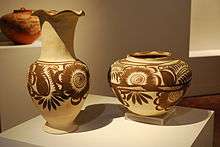

Pottery may be decorated in many different ways. Some decoration can be done before or after the firing.
Decoration
- Painting has been used since early prehistoric times, and can be very elaborate. The painting is often applied to pottery that has been fired once, and may then be overlaid with a glaze afterwards. Many pigments change colour when fired, and the painter must allow for this.
- Glaze Perhaps the most common form of decoration, that also serves as protection to the pottery, by being tougher and keeping liquid from penetrating the pottery. Glaze may be clear, especially over painting, or coloured and opaque. There is more detail in the section below.
- Carving Pottery vessels may be decorated by shallow carving of the clay body, typically with a knife or similar instrument used on the wheel. This is common in Chinese porcelain of the classic periods.
- Burnishing the surface of pottery wares may be burnished prior to firing by rubbing with a suitable instrument of wood, steel or stone to produce a polished finish that survives firing. It is possible to produce very highly polished wares when fine clays are used or when the polishing is carried out on wares that have been partially dried and contain little water, though wares in this condition are extremely fragile and the risk of breakage is high.
- Terra Sigillata is an ancient form of decorating ceramics that was first developed in Ancient Greece.
- Additives can be worked into the clay body prior to forming, to produce desired effects in the fired wares. Coarse additives such as sand and grog (fired clay which has been finely ground) are sometimes used to give the final product a required texture. Contrasting coloured clays and grogs are sometimes used to produce patterns in the finished wares. Colourants, usually metal oxides and carbonates, are added singly or in combination to achieve a desired colour. Combustible particles can be mixed with the body or pressed into the surface to produce texture.
- Lithography, also called litho, although the alternative names of transfer print or "decal" are also common. These are used to apply designs to articles. The litho comprises three layers: the colour, or image, layer which comprises the decorative design; the cover coat, a clear protective layer, which may incorporate a low-melting glass; and the backing paper on which the design is printed by screen printing or lithography. There are various methods of transferring the design while removing the backing-paper, some of which are suited to machine application.
- Banding is the application by hand or by machine of a band of colour to the edge of a plate or cup. Also known as "lining", this operation is often carried out on a potter's wheel.
- Agateware is named after its resemblance to the quartz mineral agate which has bands or layers of colour that are blended together, agatewares are made by blending clays of differing colours together but not mixing them to the extent that they lose their individual identities. The wares have a distinctive veined or mottled appearance. The term "agateware" is used to describe such wares in the United Kingdom; in Japan the term "neriage" is used and in China, where such things have been made since at least the Tang Dynasty, they are called "marbled" wares. Great care is required in the selection of clays to be used for making agatewares as the clays used must have matching thermal movement characteristics.
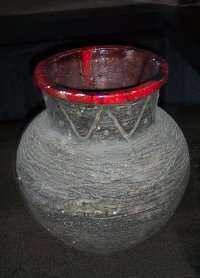
- Engobe: This is a clay slip, that is used to coat the surface of pottery, usually before firing. Its purpose is often decorative though it can also be used to mask undesirable features in the clay to which it is applied. Engobe slip may be applied by painting or by dipping to provide a uniform, smooth, coating. Engobe has been used by potters from pre-historic times until the present day and is sometimes combined with sgraffito decoration, where a layer of engobe is scratched through to reveal the colour of the underlying clay. With care it is possible to apply a second coat of engobe of a different colour to the first and to incise decoration through the second coat to expose the colour of the underlying coat. Engobes used in this way often contain substantial amounts of silica, sometimes approaching the composition of a glaze.
- Gold: Decoration with gold is used on some high quality ware. Different methods exist for its application, including:
- Best gold – a suspension of gold powder in essential oils mixed with a flux and a mercury salt extended. This can be applied by a painting technique. From the kiln, the decoration is dull and requires burnishing to reveal the full colour
- Acid Gold – a form of gold decoration developed in the early 1860s at the English factory of Mintons Ltd, Stoke-on-Trent. The glazed surface is etched with diluted hydrofluoric acid prior to application of the gold. The process demands great skill and is used for the decoration only of ware of the highest class.
- Bright Gold – consists of a solution of gold sulphoresinate together with other metal resonates and a flux. The name derives from the appearance of the decoration immediately after removal from the kiln as it requires no burnishing
- Mussel Gold – an old method of gold decoration. It was made by rubbing together gold leaf, sugar and salt, followed by washing to remove solubles
Glaze
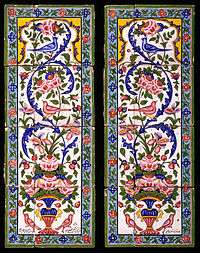
Glaze is a glassy coating on pottery, the primary purposes of which are decoration and protection. One important use of glaze is to render porous pottery vessels impermeable to water and other liquids. Glaze may be applied by dusting the unfired composition over the ware or by spraying, dipping, trailing or brushing on a thin slurry composed of the unfired glaze and water. The colour of a glaze after it has been fired may be significantly different from before firing. To prevent glazed wares sticking to kiln furniture during firing, either a small part of the object being fired (for example, the foot) is left unglazed or, alternatively, special refractory "spurs" are used as supports. These are removed and discarded after the firing.
Some specialised glazing techniques include:
- Salt-glazing, where common salt is introduced to the kiln during the firing process. The high temperatures cause the salt to volatize, depositing it on the surface of the ware to react with the body to form a sodium aluminosilicate glaze. In the 17th and 18th centuries, salt-glazing was used in the manufacture of domestic pottery. Now, except for use by some studio potters, the process is obsolete. The last large-scale application before its demise in the face of environmental clean air restrictions was in the production of salt-glazed sewer-pipes.[26][27]
- Ash glazing – ash from the combustion of plant matter has been used as the flux component of glazes. The source of the ash was generally the combustion waste from the fuelling of kilns although the potential of ash derived from arable crop wastes has been investigated.[28] Ash glazes are of historical interest in the Far East although there are reports of small-scale use in other locations such as the Catawba Valley Pottery in the United States. They are now limited to small numbers of studio potters who value the unpredictability arising from the variable nature of the raw material.[29]
- Underglaze decoration (in the manner of many blue and white wares). Underglaze may be applied by brush strokes, air brush, or by pouring the underglaze into the mould, covering the inside, creating a swirling effect, then the mould is filled with slip.
- In-glaze decoration
- On-glaze decoration
- Enamel
Firing
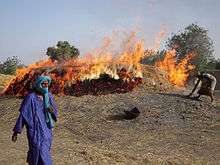
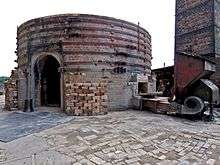
Firing produces irreversible changes in the body. It is only after firing that the article or material is pottery. In lower-fired pottery, the changes include sintering, the fusing together of coarser particles in the body at their points of contact with each other. In the case of porcelain, where different materials and higher firing-temperatures are used, the physical, chemical and mineralogical properties of the constituents in the body are greatly altered. In all cases, the reason for firing is to permanently harden the wares and the firing regime must be appropriate to the materials used to make them. As a rough guide, modern earthenwares are normally fired at temperatures in the range of about 1,000°C (1,830 °F) to 1,200 °C (2,190 °F); stonewares at between about 1,100 °C (2,010 °F) to 1,300 °C (2,370 °F); and porcelains at between about 1,200 °C (2,190 °F) to 1,400 °C (2,550 °F). Historically, reaching high temperatures was a long-lasting challenge, and earthenware can be fired effectively as low as 600°C, achievable in primitive pit firing.
Firing pottery can be done using a variety of methods, with a kiln being the usual firing method. Both the maximum temperature and the duration of firing influences the final characteristics of the ceramic. Thus, the maximum temperature within a kiln is often held constant for a period of time to soak the wares to produce the maturity required in the body of the wares.
The atmosphere within a kiln during firing can affect the appearance of the finished wares. An oxidising atmosphere, produced by allowing an excess of air in the kiln, can cause the oxidation of clays and glazes. A reducing atmosphere, produced by limiting the flow of air into the kiln, or burning coal rather than wood, can strip oxygen from the surface of clays and glazes. This can affect the appearance of the wares being fired and, for example, some glazes containing iron-rich minerals fire brown in an oxidising atmosphere, but green in a reducing atmosphere. The atmosphere within a kiln can be adjusted to produce complex effects in glaze.
Kilns may be heated by burning wood, coal and gas, or by electricity. When used as fuels, coal and wood can introduce smoke, soot and ash into the kiln which can affect the appearance of unprotected wares. For this reason, wares fired in wood- or coal-fired kilns are often placed in the kiln in saggars, ceramic boxes, to protect them. Modern kilns powered by gas or electricity are cleaner and more easily controlled than older wood- or coal-fired kilns and often allow shorter firing times to be used. In a Western adaptation of traditional Japanese Raku ware firing, wares are removed from the kiln while hot and smothered in ashes, paper or woodchips which produces a distinctive carbonised appearance. This technique is also used in Malaysia in creating traditional labu sayung.[30][31]
In Mali, a firing mound is used rather than a brick or stone kiln. Unfired pots are first brought to the place where a mound will be built, customarily by the women and girls of the village. The mound's foundation is made by placing sticks on the ground, then:
[...]pots are positioned on and amid the branches and then grass is piled high to complete the mound. Although the mound contains the pots of many women, who are related through their husbands' extended families, each women is responsible for her own or her immediate family's pots within the mound. When a mound is completed and the ground around has been swept clean of residual combustible material, a senior potter lights the fire. A handful of grass is lit and the woman runs around the circumference of the mound touching the burning torch to the dried grass. Some mounds are still being constructed as others are already burning.[32]
History
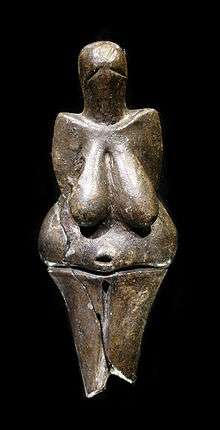
A great part of the history of pottery is prehistoric, part of past pre-literate cultures. Therefore, much of this history can only be found among the artifacts of archaeology. Because pottery is so durable, pottery and shards of pottery survive from millennia at archaeological sites, and are typically the most common and important type of artifact to survive. Many prehistoric cultures are named after the pottery that is the easiest way to identify their sites, and archaeologists develop the ability to recognise different types from the chemistry of small shards.
Before pottery becomes part of a culture, several conditions must generally be met.
- First, there must be usable clay available. Archaeological sites where the earliest pottery was found were near deposits of readily available clay that could be properly shaped and fired. China has large deposits of a variety of clays, which gave them an advantage in early development of fine pottery. Many countries have large deposits of a variety of clays.
- Second, it must be possible to heat the pottery to temperatures that will achieve the transformation from raw clay to ceramic. Methods to reliably create fires hot enough to fire pottery did not develop until late in the development of cultures.
- Third, the potter must have time available to prepare, shape and fire the clay into pottery. Even after control of fire was achieved, humans did not seem to develop pottery until a sedentary life was achieved. It has been hypothesized that pottery was developed only after humans established agriculture, which led to permanent settlements. However, the oldest known pottery is from China and dates to 20,000 BC, at the height of the ice age, long before the beginnings of agriculture.
- Fourth, there must be a sufficient need for pottery in order to justify the resources required for its production.[33]
Early pottery
- Methods of forming: Hand-shaping was the earliest method used to form vessels. This included the combination of pinching and coiling.
- Firing: The earliest method for firing pottery wares was the use of bonfires pit fired pottery. Firing times might be short but the peak-temperatures achieved in the fire could be high, perhaps in the region of 900 °C (1,650 °F), and were reached very quickly.[34]
- Clay: Early potters used whatever clay was available to them in their geographic vicinity. However, the lowest quality common red clay was adequate for low-temperature fires used for the earliest pots. Clays tempered with sand, grit, crushed shell or crushed pottery were often used to make bonfire-fired ceramics because they provided an open-body texture that allowed water and volatile components of the clay to escape freely. The coarser particles in the clay also acted to restrain shrinkage during drying, and hence reduce the risk of cracking.
- Form: In the main, early bonfire-fired wares were made with rounded bottoms to avoid sharp angles that might be susceptible to cracking.
- Glazing: the earliest pots were not glazed.
- The potter's wheel was invented in Mesopotamia sometime between 6,000 and 4,000 BC (Ubaid period) and revolutionised pottery production.
- Moulds were used to a limited extent as early as the 5th and 6th century BC by the Etruscans[35] and more extensively by the Romans.[36]
- Slipcasting, a popular method for shaping irregular shaped articles. It was first practised, to a limited extent, in China as early as the Tang dynasty.[37]
- Transition to kilns: The earliest intentionally constructed were pit-kilns or trench-kilns—holes dug in the ground and covered with fuel. Holes in the ground provided insulation and resulted in better control over firing.[38]
- Kilns: Pit fire methods were adequate for creating simple earthenware, but other pottery types needed more sophisticated kilns (see below kilns).
History by region
Beginnings of pottery
Pottery may well have been discovered independently in various places, probably by accidentally creating it at the bottom of fires on a clay soil. All the earliest vessel forms were pit fired and made by coiling, which is a simple technology to learn. The earliest-known ceramic objects are Gravettian figurines such as those discovered at Dolní Věstonice in the modern-day Czech Republic. The Venus of Dolní Věstonice is a Venus figurine, a statuette of a nude female figure dated to 29,000–25,000 BC (Gravettian industry).[2]
Sherds have been found in China and Japan from a period between 12,000 and perhaps as long as 18,000 years ago.[4][41] As of 2012, the earliest pottery found anywhere in the world,[42] dating to 20,000 to 19,000 years before the present, was found at Xianrendong Cave in the Jiangxi province of China.[43][44]
Other early pottery vessels include those excavated from the Yuchanyan Cave in southern China, dated from 16,000 BC,[41] and those found in the Amur River basin in the Russian Far East, dated from 14,000 BC.[4][45]
The Odai Yamamoto I site, belonging to the Jōmon period, currently has the oldest pottery in Japan. Excavations in 1998 uncovered earthenware fragments which have been dated as early as 14,500 BC.[46] The term "Jōmon" means "cord-marked" in Japanese. This refers to the markings made on the vessels and figures using sticks with cords during their production. Recent research has elucidated how Jōmon pottery was used by its creators.[47]
It appears that pottery was independently developed in Sub-Saharan Africa during the 10th millennium BC, with findings dating to at least 9,400 BC from central Mali,[5] and in South America during the 9,000s-7,000s BC.[48][6] The Malian finds date to the same period as similar finds from East Asia – the triangle between Siberia, China and Japan – and are associated in both regions to the same climatic changes (at the end of the ice age new grassland develops, enabling hunter-gatherers to expand their habitat), met independently by both cultures with similar developments: the creation of pottery for the storage of wild cereals (pearl millet), and that of small arrowheads for hunting small game typical of grassland.[5] Alternatively, the creation of pottery in the case of the Incipient Jōmon civilisation could be due to the intensive exploitation of freshwater and marine organisms by late glacial foragers, who started developing ceramic containers for their catch.[47]
East Asia
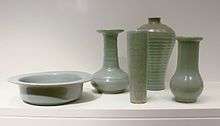
In Japan, the Jōmon period has a long history of development of Jōmon pottery which was characterized by impressions of rope on the surface of the pottery created by pressing rope into the clay before firing. Glazed Stoneware was being created as early as the 15th century BC in China. A form of Chinese porcelain became a significant Chinese export from the Tang Dynasty (AD 618–906) onwards.[8] Korean potters produced porcelain as early as the 14th century AD.[49] Koreans brought the art of porcelain to Japan in the 17th century AD.[50]
In contrast to Europe, the Chinese elite used pottery extensively at table, for religious purposes, and for decoration, and the standards of fine pottery were very high. From the Song dynasty (960–1279) for several centuries elite taste favoured plain-coloured and exquisitely formed pieces; during this period true porcelain was perfected in Ding ware, although it was the only one of the Five Great Kilns of the Song period to use it. The traditional Chinese category of high-fired wares includes stoneware types such as Ru ware, Longquan celadon, and Guan ware. Painted wares such as Cizhou ware had a lower status, though they were acceptable for making pillows.
The arrival of Chinese blue and white porcelain was probably a product of the Mongol Yuan dynasty (1271–1368) dispersing artists and craftsmen across its large empire. Both the cobalt stains used for the blue colour, and the style of painted decoration, usually based on plant shapes, were initially borrowed from the Islamic world, which the Mongols had also conquered. At the same time Jingdezhen porcelain, produced in Imperial factories, took the undisputed leading role in production, which it has retained to the present day. The new elaborately painted style was now favoured at court, and gradually more colours were added.
The secret of making such porcelain was sought in the Islamic world and later in Europe when examples were imported from the East. Many attempts were made to imitate it in Italy and France. However it was not produced outside of the Orient until 1709 in Germany.[51]
South Asia
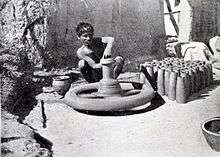
-_Geb%C3%A4ude_-_Annemarie_Schwarzenbach_-_SLA-Schwarzenbach-A-5-21-028.jpg)
Cord-Impressed style pottery belongs to 'Mesolithic' ceramic tradition that developed among Vindhya hunter-gatherers in Central India during the Mesolithic period.[52][53] This ceramic style is also found in later Proto-Neolithic phase in nearby regions.[54] This early type of pottery, also found at the site of Lahuradewa, is currently the oldest known pottery tradition in South Asia, dating back to 7,000-6,000 BC.[55][56][57][58] Wheel-made pottery began to be made during the Mehrgarh Period II (5,500–4,800 BC) and Merhgarh Period III (4,800–3,500 BC), known as the ceramic Neolithic and chalcolithic. Pottery, including items known as the ed-Dur vessels, originated in regions of the Saraswati River / Indus River and have been found in a number of sites in the Indus Civilization.[59][60]
Despite an extensive prehistoric record of pottery, including painted wares, little "fine" or luxury pottery was made in the subcontinent in historic times. Hinduism discourages eating off pottery, which probably largely accounts for this. Most traditional Indian pottery vessels are large pots or jars for storage, or small cups or lamps, often treated as disposable. In contrast there are long traditions of sculpted figures, often rather large, in terracotta.
Southeast Asia
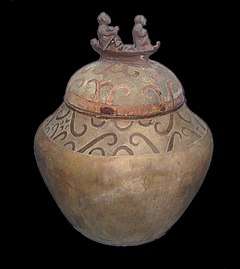
Pottery in Southeast Asia is as diverse as its ethnic groups. Each ethnic group has their own set of standards when it comes to pottery arts. Potteries are made due to various reasons, such as trade, food and beverage storage, kitchen usage, religious ceremonies, and burial purposes.[61][62][63][64]
Near East
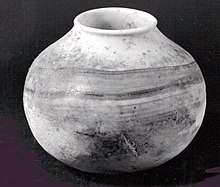
Around 8000 BC during the Pre-pottery Neolithic period, and before the invention of pottery, several early settlements became experts in crafting beautiful and highly sophisticated containers from stone, using materials such as alabaster or granite, and employing sand to shape and polish. Artisans used the veins in the material to maximum visual effect. Such objects have been found in abundance on the upper Euphrates river, in what is today eastern Syria, especially at the site of Bouqras.[65]
The earliest history of pottery production in the Fertile Crescent starts the Pottery Neolithic and can be divided into four periods, namely: the Hassuna period (7000–6500 BC), the Halaf period (6500–5500 BC), the Ubaid period (5500–4000 BC), and the Uruk period (4000–3100 BC). By about 5000 BC pottery-making was becoming widespread across the region, and spreading out from it to neighbouring areas.
Pottery making began in the 7th millennium BC. The earliest forms, which were found at the Hassuna site, were hand formed from slabs, undecorated, unglazed low-fired pots made from reddish-brown clays.[38] Within the next millennium, wares were decorated with elaborate painted designs and natural forms, incising and burnished.
The invention of the potter's wheel in Mesopotamia sometime between 6000 and 4000 BC (Ubaid period) revolutionized pottery production. Newer kiln designs could fire wares to 1,050 °C (1,920 °F) to 1,200 °C (2,190 °F) which enabled new possibilities and new preparation of clays. Production was now carried out by small groups of potters for small cities, rather than individuals making wares for a family. The shapes and range of uses for ceramics and pottery expanded beyond simple vessels to store and carry to specialized cooking utensils, pot stands and rat traps.[66] As the region developed, new organizations and political forms, pottery became more elaborate and varied. Some wares were made using moulds, allowing for increased production for the needs of the growing populations. Glazing was commonly used and pottery was more decorated.[67]
In the Chalcolithic period in Mesopotamia, Halafian pottery achieved a level of technical competence and sophistication, not seen until the later developments of Greek pottery with Corinthian and Attic ware.
Europe
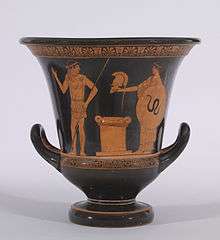
The early inhabitants of Europe developed pottery in the Linear Pottery culture slightly later than the Near East, circa 5500–4500 BC. In the ancient Western Mediterranean elaborately painted earthenware reached very high levels of artistic achievement in the Greek world; there are large numbers of survivals from tombs. Minoan pottery was characterized by complex painted decoration with natural themes.[68] The classical Greek culture began to emerge around 1000 BC featuring a variety of well crafted pottery which now included the human form as a decorating motif. The pottery wheel was now in regular use. Although glazing was known to these potters, it was not widely used. Instead, a more porous clay slip was used for decoration. A wide range of shapes for different uses developed early and remained essentially unchanged during Greek history.[69]
Fine Etruscan pottery was heavily influenced by Greek pottery and often imported Greek potters and painters. Ancient Roman pottery made much less use of painting, but used moulded decoration, allowing industrialized production on a huge scale. Much of the so-called red Samian ware of the Early Roman Empire was in fact produced in modern Germany and France, where entrepreneurs established large potteries.
Pottery was hardly seen on the tables of elites from Hellenistic times until the Renaissance, and most medieval wares were coarse and utilitarian, as the elites ate off metal vessels. Imports from Asia revived interest in fine pottery, which European manufacturers eventually learned to make, and from the 18th century European porcelain and other wares from a great number of producers became extremely popular.
United Kingdom
The English city of Stoke-on-Trent is widely known as "The Potteries" because of the large number of pottery factories or, colloquially, "Pot Banks." It was one of the first industrial cities of the modern era where, as early as 1785, two hundred pottery manufacturers employed 20,000 workers.[70][71] Josiah Wedgwood (1730–1795) was the dominant leader.[72]
In North Staffordshire hundreds of companies produced all kinds of pottery, from tablewares and decorative pieces to industrial items. The main pottery types of earthenware, stoneware and porcelain were all made in large quantities, and the Staffordshire industry was a major innovator in developing new varieties of ceramic bodies such as bone china and jasperware, as well as pioneering transfer printing and other glazing and decorating techniques. In general Staffordshire was strongest in the middle and low price ranges, though the finest and most expensive types of wares were also made.[73]
By the late 18th century North Staffordshire was the largest producer of ceramics in Britain, despite significant centres elsewhere. Large export markets took Staffordshire pottery around the world, especially in the 19th century.[74] Production had begun to decline in the late 19th century, as other countries developed their industries, and declined steeply after World War II. Some production continues in the area, but at a fraction of the levels at the peak of the industry.
Islamic pottery
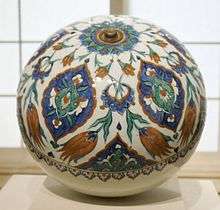

Early Islamic pottery followed the forms of the regions which the Muslims conquered. Eventually, however, there was cross-fertilization between the regions. This was most notable in the Chinese influences on Islamic pottery. Trade between China and Islam took place via the system of trading posts over the lengthy Silk Road. Islamic nations imported stoneware and later porcelain from China. China imported the minerals for Cobalt blue from the Islamic ruled Persia to decorate their blue and white porcelain, which they then exported to the Islamic world.
Likewise, Islamic art contributed to a lasting pottery form identified as Hispano-Moresque in Andalucia (Islamic Spain). Unique Islamic forms were also developed, including fritware, lusterware and specialized glazes like tin-glazing, which led to the development of the popular maiolica.[75]
One major emphasis in ceramic development in the Muslim world was the use of tile and decorative tilework.
Americas
Most evidence points to an independent development of pottery in the Native American cultures, with the earliest known dates from Brazil, from 9,500 to 5,000 years ago and 7,000 to 6,000 years ago.[6] Further north in Mesoamerica, dates begin with the Archaic Era (3500–2000 BC), and into the Formative period (2000 BC – AD 200). These cultures did not develop the stoneware, porcelain or glazes found in the Old World. Maya ceramics include finely painted vessels, usually beakers, with elaborate scenes with several figures and texts. Several cultures, beginning with the Olmec, made terracotta sculpture, and sculptural pieces of humans or animals that are also vessels are produced in many places, with Moche portrait vessels among the finest.
Africa
Evidence indicates an independent invention of pottery in Sub-Saharan Africa. In 2007, Swiss archaeologists discovered pieces of the oldest pottery in Africa at Ounjougou in Central Mali, dating back to at least 9,400 BC.[5] In later periods, a relationship of the introduction of pot-making in some parts of Sub-Saharan Africa with the spread of Bantu languages has been long recognized, although the details remain controversial and awaiting further research, and no consensus has been reached.[76]
Ancient Egyptian pottery begins after 5,000 BC, having spread from the Levant. There were many distinct phases of development in pottery, with very sophisticated wares being produced by the Naqada III period, c. 3,200 to 3,000 BC. During the early Mediterranean civilizations of the fertile crescent, Egypt developed a non-clay-based ceramic which has come to be called Egyptian faience.[note 1] A similar type of body is still made in Jaipur in India. During the Umayyad Caliphate of Islam, Egypt was a link between early centre of Islam in the Near East and Iberia which led to the impressive style of pottery.
It is, however, still valuable to look into pottery as an archaeological record of potential interaction between peoples, especially in areas where little or no written history exists. Because Africa is primarily heavy in oral traditions, and thus lacks a large body of written historical sources, pottery has a valuable archaeological role. When pottery is placed within the context of linguistic and migratory patterns, it becomes an even more prevalent category of social artifact.[76] As proposed by Olivier P. Gosselain, it is possible to understand ranges of cross-cultural interaction by looking closely at the chaîne opératoire of ceramic production.[77]
The methods used to produce pottery in early Sub-Saharan Africa are divisible into three categories: techniques visible to the eye (decoration, firing and post-firing techniques), techniques related to the materials (selection or processing of clay, etc.), and techniques of molding or fashioning the clay.[77] These three categories can be used to consider the implications of the reoccurrence of a particular sort of pottery in different areas. Generally, the techniques that are easily visible (the first category of those mentioned above) are thus readily imitated, and may indicate a more distant connection between groups, such as trade in the same market or even relatively close proximity in settlements.[77] Techniques that require more studied replication (i.e., the selection of clay and the fashioning of clay) may indicate a closer connection between peoples, as these methods are usually only transmissible between potters and those otherwise directly involved in production.[77] Such a relationship requires the ability of the involved parties to communicate effectively, implying pre-existing norms of contact or a shared language between the two. Thus, the patterns of technical diffusion in pot-making that are visible via archaeological findings also reveal patterns in societal interaction.
Oceania
Polynesia, Melanesia and Micronesia
Pottery has been found in archaeological sites across the islands of Oceania. It is attributed to an ancient archaeological culture called the Lapita. Another form of pottery called Plainware is found throughout sites of Oceania. The relationship between Lapita pottery and Plainware is not altogether clear.
The Indigenous Australians never developed pottery.[78] After Europeans came to Australia and settled, they found deposits of clay which were analysed by English potters as excellent for making pottery. Less than 20 years later, Europeans came to Australia and began creating pottery. Since then, ceramic manufacturing, mass-produced pottery and studio pottery have flourished in Australia.[79]
Archaeology
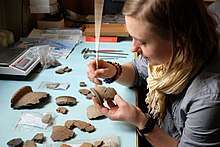
The study of pottery can help to provide an insight into past cultures. Pottery is durable, and fragments, at least, often survive long after artefacts made from less-durable materials have decayed past recognition. Combined with other evidence, the study of pottery artefacts is helpful in the development of theories on the organisation, economic condition and the cultural development of the societies that produced or acquired pottery. The study of pottery may also allow inferences to be drawn about a culture's daily life, religion, social relationships, attitudes towards neighbours, attitudes to their own world and even the way the culture understood the universe.
Chronologies based on pottery are often essential for dating non-literate cultures and are often of help in the dating of historic cultures as well. Trace-element analysis, mostly by neutron activation, allows the sources of clay to be accurately identified and the thermoluminescence test can be used to provide an estimate of the date of last firing. Examining fired pottery shards from prehistory, scientists learned that during high-temperature firing, iron materials in clay record the exact state of Earth's magnetic field at that exact moment.
Health and environmental issues in production
Although many of the environmental effects of pottery production have existed for millennia, some of these have been amplified with modern technology and scales of production. The principal factors for consideration fall into two categories: (a) effects on workers, and (b) effects on the general environment.
The chief risks on worker health include heavy metal poisoning, poor indoor air quality, dangerous sound levels and possible over-illumination.
Historically, "plumbism" (lead poisoning) was a significant health concern to those glazing pottery. This was recognised at least as early as the nineteenth century, and the first legislation in the United Kingdom to limit pottery workers' exposure was introduced in 1899.[80]
Proper ventilation to guarantee adequate indoor air quality can reduce or eliminate workers' exposure to fine particulate matter, carbon monoxide, certain heavy metals, and crystalline silica (which can lead to silicosis). A more recent study at Laney College, Oakland, California suggests that all these factors can be controlled in a well-designed workshop environment.[81]
The primary environmental concerns include off-site water pollution, air pollution, disposal of hazardous materials, and fuel consumption.
See also
- Glossary of pottery terms
- American art pottery
- Celadon
- Ceramics of indigenous peoples of the Americas
- Chinese ceramics including porcelain
- Delftware
- Dipped ware
- Faience
- History of ceramic art
- Ironstone ware
- Jasperware
- Korean ceramics
- Kakiemon pottery
- Longquan celadon
- Maiolica of Renaissance Italy
- Majolica
- Palissy ware
- Persian pottery
- Sancai
- Sea pottery
- Slipware
- SylvaC
- Victorian majolica
Notes
- The non-clay ceramic called Egyptian faience should not be confused with faience, which is a type of glaze.
Notes
- 'Standard Terminology Of Ceramic Whitewares And Related Products.' ASTM C 242–01 (2007.) ASTM International.
- "No. 359: The Dolni Vestonice Ceramics". Uh.edu. 1989-11-24. Archived from the original on 2010-01-09. Retrieved 2010-09-04.
- Diamond, Jared (June 1998). "Japanese Roots". Discover. Discover Media LLC. Archived from the original on 2010-03-11. Retrieved 2010-07-10.
- 'AMS 14C Age Of The Earliest Pottery From The Russian Far East; 1996–2002.' Derevianko A.P., Kuzmin Y.V., Burr G.S., Jull A.J.T., Kim J.C. Nuclear Instruments And Methods In Physics Research. B223–224 (2004) 735–39.
- Simon Bradley, A Swiss-led team of archaeologists has discovered pieces of the oldest African pottery in central Mali, dating back to at least 9,400BC Archived 2012-03-06 at the Wayback Machine, SWI swissinfo.ch – the international service of the Swiss Broadcasting Corporation (SBC), 18 January 2007
- Roosevelt, Anna C. (1996). "The Maritime, Highland, Forest Dynamic and the Origins of Complex Culture". In Frank Salomon; Stuart B. Schwartz (eds.). The Cambridge History of the Native Peoples of the Americas. Cambridge, England New York: Cambridge University Press. pp. 264–349. ISBN 978-0-521-63075-7.CS1 maint: ref=harv (link)
- "Art & Architecture Thesaurus Full Record Display (Getty Research)". www.getty.edu. Archived from the original on 22 December 2017. Retrieved 30 April 2018.
- Cooper (2010), p. 54
- Crabtree, Pamela, ed., Medieval Archaeology, Routledge Encyclopedias of the Middle Ages, 2013, Routledge, ISBN 1-135-58298-X, 9781135582982, google books
- Cooper (2010), pp. 72–79, 160–79
- "The Fast Firing Of Biscuit Earthenware Hollow-Ware In a Single-Layer Tunnel Kiln." Salt D.L. Holmes W.H. RP737. Ceram Research.
- "New And Latest Biscuit Firing Technology". Porzellanfabriken Christian Seltmann GmbH. Ceram.Forum Int./Ber.DKG 87, No. 1/2, pp. E33–E34, E36. 2010
- "Whitewares: Production, Testing And Quality Control." W.Ryan & C.Radford. Pergamon Press. 1987
- Ruth M. Home, 'Ceramics for the Potter', Chas. A. Bennett Co., 1952
- Home, 1952, p. 16
- Dennis Krueger, Why On Earth Do They Call It Throwing?, in Ceramics Today Archived 2007-02-03 at the Wayback Machine
- "Novel Approach To Injection Moulding." M.Y.Anwar, P.F. Messer, H.A. Davies, B. Ellis. Ceramic Technology International 1996. Sterling Publications Ltd., London, 1995. pp. 95–96, 98.
- "Injection Moulding Of Porcelain Pieces." A. Odriozola, M.Gutierrez, U.Haupt, A.Centeno. Bol. Soc. Esp. Ceram. Vidrio 35, No. 2, 1996. pp. 103–07
- "Injection Moulding Of Cups With Handles." U.Haupt. International Ceramics. No. 2, 1998, pp. 48–51.
- "Injection Moulding Technology In Tableware Production." Ceramic World Review. 13, No. 54, 2003. pp. 94, 96–97.
- An Introduction To The Technology Of Pottery. Paul Rado. Pergamon Press. 1969
- 'Sanitaryware Technology'. Domenico Fortuna. Gruppo Editoriale Faenza Editrice S.p.A. 2000.
- "DGM-E.pdf" (PDF). Retrieved 2010-09-04.
- "Ceramicindustry.com". Ceramicindustry.com. 2000-11-21. Archived from the original on 2011-07-08. Retrieved 2010-09-04.
- Dictionary Of Ceramics. Arthur Dodd & David Murfin. 3rd edition. The Institute Of Minerals. 1994.
- "Clay Sewer Pipe Manufacture. Part II – The Effect Of Variable Alumina, Silica And Iron Oxide In Clays On Some Properties Of Salt Glazes." H.G. Schurecht. The Journal of the American Ceramic Society. Volume 6. Issue 6, pp. 717–29.
- "Dictionary Of Ceramics." Arthur Dodd & David Murfin. 3rd edition. The Institute Of Minerals. 1994.
- "Ash Glaze Research." C. Metcalfe. Ceramic Review No. 202. 2003. pp. 48–50.
- "Glaze From Wood Ashes And Their Colour Characteristics." Y-S. Han, B-H. Lee. Korean Ceramic Society 41. No. 2. 2004.
- "History of Pottery". Brothers-handmade.com. Archived from the original on 2013-06-01. Retrieved 2010-09-04.
- Malaxi Teams. "Labu Sayong, Perak". Malaxi.com. Archived from the original on 2012-11-04. Retrieved 2010-09-04.
- Goldner, Janet (Spring 2007). "The women of Kalabougou". African Arts. 40 (1): 74–79. doi:10.1162/afar.2007.40.1.74.
- William K. Barnett and John W. Hoopes, The Emergence of Pottery: Technology and Innovation in Ancient Society, Smithsonian Institution Press, 1995, p. 19
- Metropolitan Museum of Art "Archived copy". Archived from the original on 2011-09-06. Retrieved 2011-09-15.CS1 maint: archived copy as title (link)
- Glenn C. Nelson, Ceramics: A Potter's Handbook,1966, Holt, Rinehart and Winston, Inc., p. 251
- Cooper (2010)
- Nelson (1966), p. 251
- Cooper (2010), p. 16
- Bar-Yosef, Ofer; Arpin, Trina; Pan, Yan; Cohen, David; Goldberg, Paul; Zhang, Chi; Wu, Xiaohong (29 June 2012). "Early Pottery at 20,000 Years Ago in Xianrendong Cave, China". Science. 336 (6089): 1696–1700. Bibcode:2012Sci...336.1696W. doi:10.1126/science.1218643. ISSN 0036-8075. PMID 22745428.
- Marshall, Michael (2012). "Oldest pottery hints at cooking's ice-age origins". New Scientist. 215 (2872): 14. Bibcode:2012NewSc.215Q..14M. doi:10.1016/S0262-4079(12)61728-X.
- "Chinese pottery may be earliest discovered." Archived 2012-10-06 at the Wayback Machine Associated Press. 2009-06-01.
- "Remnants of an Ancient Kitchen Are Found in China" Archived 2017-03-15 at the Wayback Machine. The New York Times.
- Wu, X.; Zhang, C.; Goldberg, P.; Cohen, D.; Pan, Y.; Arpin, T.; Bar-Yosef, O. (June 29, 2012). "Early Pottery at 20,000 Years Ago in Xianrendong Cave, China". Science. 336 (6089): 1696–700. Bibcode:2012Sci...336.1696W. doi:10.1126/science.1218643. PMID 22745428.
- "Harvard, BU researchers find evidence of 20,000-year-old pottery" Archived 2017-07-28 at the Wayback Machine. The Boston Globe.
- 'Radiocarbon Dating Of Charcoal And Bone Collagen Associated With Early Pottery At Yuchanyan Cave, Hunan Province, China.' Boaretto E., Wu X., Yuan J., Bar-Yosef O., Chu V., Pan Y., Liu K., Cohen D., Jiao T., Li S., Gu H., Goldberg P., Weiner S. Proceedings of the National Academy of Sciences USA. June 2009. 16;106(24): 9595–600.
- Kainer, Simon (September 2003). "The Oldest Pottery in the World" (PDF). Current World Archaeology. Robert Selkirk. pp. 44–49. Archived from the original on 2006-04-23. Retrieved 2016-09-27.CS1 maint: BOT: original-url status unknown (link)
- O.E. Craig, H. Saul, A. Lucquin, Y. Nishida, K. Taché, L. Clarke, A. Thompson, D.T. Altoft, J. Uchiyama, M. Ajimoto, K. Gibbs, S. Isaksson, C.P. Heron P. Jordan (18 April 2013). "Earliest evidence for the use of pottery". Nature. 496 (7445): 351–54. arXiv:1510.02343. Bibcode:2013Natur.496..351C. doi:10.1038/nature12109. hdl:10454/5947. PMID 23575637.CS1 maint: multiple names: authors list (link)
- Barnett & Hoopes 1995:211
- Cooper (2010), p. 75
- Cooper (2010), p. 79
- Cooper (2010), pp. 160–62
- D. Petraglia, Michael (26 March 2007). The Evolution and History of Human Populations in South Asia (2007 ed.). Springer. p. 407. ISBN 9781402055614. Retrieved 26 March 2007.
- Bulletin of the Deccan College Research Institute, Volume 49, Dr. A. M. Ghatage, Page 303-304
- Upinder Singh (2008). A History of Ancient and Early Medieval India: From the Stone age to the 12th century. p. 76. ISBN 9788131716779.
- Peter Bellwood; Immanuel Ness (2014-11-10). The Global Prehistory of Human Migration. John Wiley & Sons. p. 250. ISBN 9781118970591.
- Gwen Robbins Schug; Subhash R. Walimbe (2016-04-13). A Companion to South Asia in the Past. John Wiley & Sons. p. 350. ISBN 9781119055471.
- Barker, Graeme; Goucher, Candice (2015). The Cambridge World History: Volume 2, A World with Agriculture, 12,000 BCE–500 CE. Cambridge University Press. p. 470. ISBN 9781316297780.
- Cahill, Michael A. (2012). Paradise Rediscovered: The Roots of Civilisation. Interactive Publications. p. 104. ISBN 9781921869488.
- Proceedings, American Philosophical Society (vol. 85, 1942). ISBN 1-4223-7221-9
- Archaeology of the United Arab Emirates: Proceedings of the First International Conference on the Archaeology of the U.A.E. By Daniel T. Potts, Hasan Al Naboodah, Peter Hellyer. Contributor Daniel T. Potts, Hasan Al Naboodah, Peter Hellyer. Published 2003. Trident Press Ltd. ISBN 1-900724-88-X
- The pottery trail from Southeast Asia to remote Oceania, MT Carson, H Hung, G Summerhayes, 2013
- The incised & impressed pottery style of mainland Southeast Asia: following the paths of Neolithization F Rispoli - East and West, 2007
- Sa-huỳnh Related Pottery in Southeast Asia WG Solheim - Asian Perspectives, 1959
- The Kulanay pottery complex in the Philippines WG Solheim - Artibus Asiae, 1957
- "Metropolitan Museum of Art". www.metmuseum.org.
- Cooper (2010), pp. 19–20
- Cooper (2010), pp. 20–24
- Cooper (2010), pp. 36–37
- Cooper (2010), p. 42
- Richard Whipp, Patterns of Labour - Work and Social Change in the Pottery Industry (1990).
- Simeon Shaw, History of the Staffordshire Potteries: And the Rise and Progress of the Manufacture of Pottery and Porcelain; with References to Genuine Specimens, and Notices of Eminent Potters (1900) online.
- Brian Dolan, Wedgwood: The First Tycoon (2004).
- Aileen Dawson, ""The Growth of the Staffordshire Ceramic Industry", in Freestone, Ian, Gaimster, David R. M. (eds), Pottery in the Making: World Ceramic Traditions (1997), pp 200-205
- Dawson, 200-201
- Nelson (1966), pp. 23–26
- See Koen Bostoen, "Pots, Words and the Bantu Problem: On Lexical Reconstruction and Early African History", Journal of African History Archived 2016-08-19 at the Wayback Machine, 48 (2007), pp. 173–99 for a recent discussion of the issues, and links to further literature.
- See Olivier P. Gosselain, [Gosselain, Olivier P. "Materializing Identities: An African Perspective." The Journal of Archaeological Method and Theory 7.3 (2000): 187–217.] for further discussion and sources.
- Aboriginal Culture: Introduction Archived 2015-03-16 at the Wayback Machine
- History of Australian Pottery Archived 2012-03-17 at the Wayback Machine
- Health Risks In A Victorian Pottery Archived 2012-07-07 at the Wayback Machine
- Indoor air quality evaluation for the Butler Building Ceramics Laboratory, Laney College, Oakland, California, Earth Metrics Incorporated, Alameda County Schools Insurance Association, December, 1989
References
- Cooper, Emmanuel, 10,000 Years of Pottery, 4th ed., 2010, University of Pennsylvania Press ISBN 978-0-8122-2140-4
- Savage, George, Pottery Through the Ages, Penguin, 1959
Further reading
- ASTM Standard C 242-01 Standard Terminology of Ceramic Whitewares and Related Products
- Ashmore, Wendy & Sharer, Robert J., (2000). Discovering Our Past: A Brief Introduction to Archaeology Third Edition. Mountain View, CA: Mayfield Publishing Company. ISBN 978-0-07-297882-7
- Barnett, William & Hoopes, John (Eds.) (1995). The Emergence of Pottery. Washington: Smithsonian Institution Press. ISBN 1-56098-517-8
- Childe, V.G., (1951). Man Makes Himself. London: Watts & Co.
- Freestone, Ian, Gaimster, David R.M., Pottery in the Making: World Ceramic Traditions, 1997, British Museum Publications, ISBN 0-7141-1782-X
- Rice, Prudence M. (1987). Pottery Analysis – A Sourcebook. Chicago: University of Chicago Press. ISBN 0-226-71118-8.
- van der Veen, V. (2018). Form Follows Function. A new approach to determining vessel function. Internet Archaeology 50. https://doi.org/10.11141/ia.50.2
External links
| Wikiquote has quotations related to: Pottery |
| Wikimedia Commons has media related to Pottery. |
- Pottery manufacture in recent past
- Stoke-on-Trent Museums - Ceramics Collections Online
- Ancient pottery in Canada
- Ceramics everywhere
- Liverani, Mario (2013). The Ancient Near East: History, Society and Economy. Routledge. p. 13, Table 1.1 "Chronology of the Ancient Near East". ISBN 9781134750917.
- Shukurov, Anvar; Sarson, Graeme R.; Gangal, Kavita (7 May 2014). "The Near-Eastern Roots of the Neolithic in South Asia". PLOS ONE. 9 (5): e95714. Bibcode:2014PLoSO...995714G. doi:10.1371/journal.pone.0095714. ISSN 1932-6203. PMC 4012948. PMID 24806472.
- Bar-Yosef, Ofer; Arpin, Trina; Pan, Yan; Cohen, David; Goldberg, Paul; Zhang, Chi; Wu, Xiaohong (29 June 2012). "Early Pottery at 20,000 Years Ago in Xianrendong Cave, China". Science. 336 (6089): 1696–1700. Bibcode:2012Sci...336.1696W. doi:10.1126/science.1218643. ISSN 0036-8075. PMID 22745428.
- Thorpe, I. J. (2003). The Origins of Agriculture in Europe. Routledge. p. 14. ISBN 9781134620104.
- Price, T. Douglas (2000). Europe's First Farmers. Cambridge University Press. p. 3. ISBN 9780521665728.
- Jr, William H. Stiebing; Helft, Susan N. (2017). Ancient Near Eastern History and Culture. Routledge. p. 25. ISBN 9781134880836.
%2C_pottery_market.jpg)
